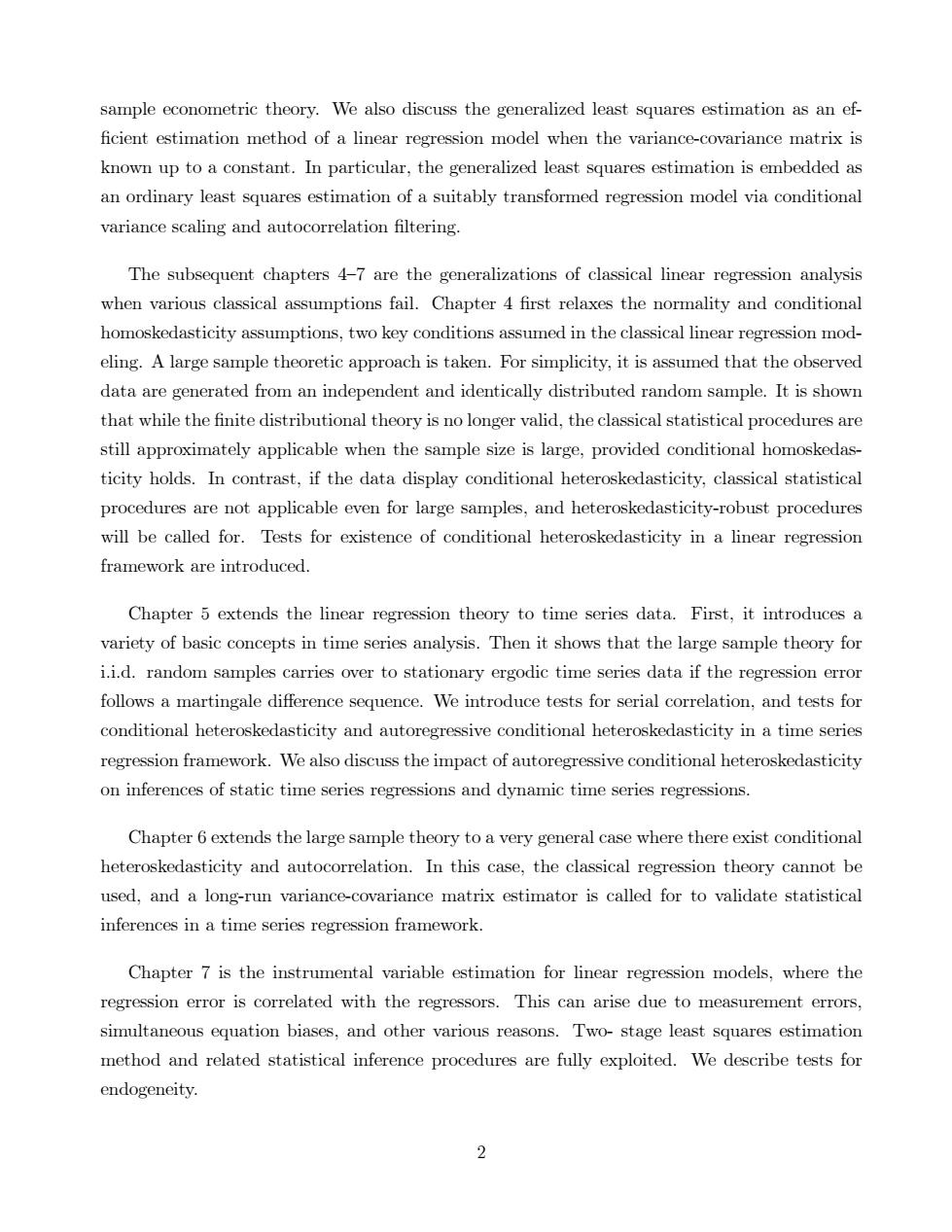正在加载图片...

sample econometric theory.We also discuss the generalized least squares estimation as an ef- ficient estimation method of a linear regression model when the variance-covariance matrix is known up to a constant.In particular,the generalized least squares estimation is embedded as an ordinary least squares estimation of a suitably transformed regression model via conditional variance scaling and autocorrelation filtering The subsequent chapters 4-7 are the generalizations of classical linear regression analysis when various classical assumptions fail.Chapter 4 first relaxes the normality and conditional homoskedasticity assumptions,two key conditions assumed in the classical linear regression mod- eling.A large sample theoretic approach is taken.For simplicity,it is assumed that the observed data are generated from an independent and identically distributed random sample.It is shown that while the finite distributional theory is no longer valid,the classical statistical procedures are still approximately applicable when the sample size is large,provided conditional homoskedas- ticity holds.In contrast,if the data display conditional heteroskedasticity,classical statistical procedures are not applicable even for large samples,and heteroskedasticity-robust procedures will be called for.Tests for existence of conditional heteroskedasticity in a linear regression framework are introduced. Chapter 5 extends the linear regression theory to time series data.First,it introduces a variety of basic concepts in time series analysis.Then it shows that the large sample theory for i.i.d.random samples carries over to stationary ergodic time series data if the regression error follows a martingale difference sequence.We introduce tests for serial correlation,and tests for conditional heteroskedasticity and autoregressive conditional heteroskedasticity in a time series regression framework.We also discuss the impact of autoregressive conditional heteroskedasticity on inferences of static time series regressions and dynamic time series regressions. Chapter 6 extends the large sample theory to a very general case where there exist conditional heteroskedasticity and autocorrelation.In this case,the classical regression theory cannot be used,and a long-run variance-covariance matrix estimator is called for to validate statistical inferences in a time series regression framework. Chapter 7 is the instrumental variable estimation for linear regression models,where the regression error is correlated with the regressors.This can arise due to measurement errors, simultaneous equation biases,and other various reasons.Two-stage least squares estimation method and related statistical inference procedures are fully exploited.We describe tests for endogeneity. 2sample econometric theory. We also discuss the generalized least squares estimation as an ef- Öcient estimation method of a linear regression model when the variance-covariance matrix is known up to a constant. In particular, the generalized least squares estimation is embedded as an ordinary least squares estimation of a suitably transformed regression model via conditional variance scaling and autocorrelation Öltering. The subsequent chapters 4ñ7 are the generalizations of classical linear regression analysis when various classical assumptions fail. Chapter 4 Örst relaxes the normality and conditional homoskedasticity assumptions, two key conditions assumed in the classical linear regression modeling. A large sample theoretic approach is taken. For simplicity, it is assumed that the observed data are generated from an independent and identically distributed random sample. It is shown that while the Önite distributional theory is no longer valid, the classical statistical procedures are still approximately applicable when the sample size is large, provided conditional homoskedasticity holds. In contrast, if the data display conditional heteroskedasticity, classical statistical procedures are not applicable even for large samples, and heteroskedasticity-robust procedures will be called for. Tests for existence of conditional heteroskedasticity in a linear regression framework are introduced. Chapter 5 extends the linear regression theory to time series data. First, it introduces a variety of basic concepts in time series analysis. Then it shows that the large sample theory for i.i.d. random samples carries over to stationary ergodic time series data if the regression error follows a martingale di§erence sequence. We introduce tests for serial correlation, and tests for conditional heteroskedasticity and autoregressive conditional heteroskedasticity in a time series regression framework. We also discuss the impact of autoregressive conditional heteroskedasticity on inferences of static time series regressions and dynamic time series regressions. Chapter 6 extends the large sample theory to a very general case where there exist conditional heteroskedasticity and autocorrelation. In this case, the classical regression theory cannot be used, and a long-run variance-covariance matrix estimator is called for to validate statistical inferences in a time series regression framework. Chapter 7 is the instrumental variable estimation for linear regression models, where the regression error is correlated with the regressors. This can arise due to measurement errors, simultaneous equation biases, and other various reasons. Two- stage least squares estimation method and related statistical inference procedures are fully exploited. We describe tests for endogeneity. 2